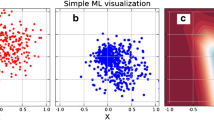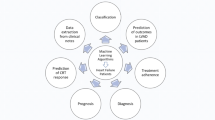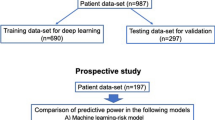Abstract
Heart failure is a debilitating clinical syndrome associated with increased morbidity, mortality, and frequent hospitalization, leading to increased healthcare budget utilization. Despite the exponential growth in the introduction of pharmacological agents and medical devices that improve survival, many heart failure patients, particularly those with a left ventricular ejection fraction less than 40%, still experience persistent clinical symptoms that lead to an overall decreased quality of life. Clinical risk prediction is one of the strategies that has been implemented for the selection of high-risk patients and for guiding therapy. However, most risk predictive models have not been well-integrated into the clinical setting. This is partly due to inherent limitations, such as creating risk predicting models using static clinical data that does not consider the dynamic nature of heart failure. Another limiting factor preventing clinicians from utilizing risk prediction models is the lack of insight into how predictive models are built. This review article focuses on describing how predictive models for risk-stratification of patients with heart failure are built.





Similar content being viewed by others
Abbreviations
- ANN:
-
Artificial neural networks
- AUC:
-
Area under the curve
- CI:
-
Confidence interval
- INTER-CHF:
-
International Congestive Heart Failure
- KNN:
-
K-nearest neighbors
- LR:
-
Linear regression
- LVEF:
-
Left ventricular ejection fraction
- NB:
-
Naïve Bayes
- NYHA:
-
New York Heart Association
- PRAISE:
-
Prospective Randomized Amlodipine Survival Evaluation
- SHF:
-
Seattle Heart Failure
- SVM:
-
Support vector machine
References
Lippi G, Sanchis-Gomar F (2020) Global epidemiology and future trends of heart failure. AME Med J 2020(5):15
Dokainish H, Teo K, Zhu J, Roy A, AlHabib KF, ElSayed A et al (2017) Global mortality variations in patients with heart failure: results from the International Congestive Heart Failure (INTER-CHF) prospective cohort study. Lancet Glob Health 5(7):e665–e672
Concise Oxford English Dictionary, 11th ed. 2006. Oxford University Press, New York
Rahimi K, Bennett D, Conrad N, Williams TM, Basu J, Dwight J, Woodward M, Patel A, McMurray J, MacMahon S (2014) Risk prediction in patients with heart failure: a systematic review and analysis. JACC Heart Fail 2(5):440–446
Di Tanna GL, Wirtz H, Burrows KL, Globe G (2020) Evaluating risk prediction models for adults with heart failure: A systematic literature review. PLoS ONE 15(1): e0224135. https://doi.org/10.1371/journal.pone.0224135
Schneider A, Hommel G, Blettner M (2010) Linear regression analysis: part 14 of a series on evaluation of scientific publications. Dtsch Arztebl Int 107(44):776–782
Alexopoulos EC (2010) Introduction to multivariate regression analysis. Hippokratia 14(Suppl 1):23–28
Zhang Z (2016) Model building strategy for logistic regression: purposeful selection. Ann Transl Med 4(6):111–111
Mickey RM, Greenland S (1989) The impact of confounder selection criteria on effect estimation. Am J Epidemiol 129(1):125–137
Pandis N (2017) Logistic regression: part 1. Am J Orthod Dentofac Orthop 151(4):824–825
Levy WC, Mozaffarian D, Linker DT, Sutradhar SC, Anker SD, Cropp AB, Anand I, Maggioni A, Burton P, Sullivan MD, Pitt B, Poole-Wilson PA, Mann DL, Packer M (2006) The Seattle Heart Failure Model: prediction of survival in heart failure. Circulation 113(11):1424–1433
Giolo SR, Krieger JE, Mansur AJ, Pereira AC (2012) Survival analysis of patients with heart failure: implications of time-varying regression effects in modeling mortality. PLoS One 7(6):e37392–e37392
Awad M, Khanna R (2015) Machine learning. In: Efficient learning machines: theories, concepts, and applications for engineers and system designers. Apress, Berkeley, pp 1–18
Ahmad T, Lund LH, Rao P, Ghosh R, Warier P, Vaccaro B et al (2018) Machine learning methods improve prognostication, identify clinically distinct phenotypes, and detect heterogeneity in response to therapy in a large cohort of heart failure patients. J Am Heart Assoc 7(8):e008081
Choy G, Khalilzadeh O, Michalski M, Do S, Samir AE, Pianykh OS et al (2018) Current applications and future impact of machine learning in radiology. Radiology 288(2):318–328
Song Y-Y, Lu Y (2015) Decision tree methods: applications for classification and prediction. Shanghai Arch Psychiatry 27(2):130–135
Kingsford C, Salzberg SL (2008) What are decision trees? Nat Biotechnol 26(9):1011–1013
Uddin S, Khan A, Hossain ME, Moni MA (2019) Comparing different supervised machine learning algorithms for disease prediction. BMC Med Inform Decis Mak 19(1):281
Fawagreh K, Gaber MM, Elyan E (2014) Random forests: from early developments to recent advancements. Syst Sci Control Eng 2(1):602-609. https://doi.org/10.1080/21642583.2014.956265
Shmilovici A (2005) Support vector machines. In: Maimon O, Rokach L (eds) Data mining and knowledge discovery handbook. Springer US, Boston, pp 257–276
Hackenberger BK (2019) Bayes or not Bayes, is this the question? Croat Med J 60(1):50–52
Ali L, Khan SU, Golilarz NA, Yakubu I, Qasim I, Noor A et al (2019) A feature-driven decision support system for heart failure prediction based on statistical model and Gaussian Naive Bayes. Comput Math Methods Med 2019:6314328
Pakhomov SV, Buntrock J, Chute CG (2005) Prospective recruitment of patients with congestive heart failure using an ad-hoc binary classifier. J Biomed Inform 38(2):145–153
Sengupta S, Basak S, Saikia P, Paul S, Tsalavoutis V, Atiah F, Ravi V, Peters A (2020) A review of deep learning with special emphasis on architectures, applications and recent trends. Knowl-Based Syst 194:105596
Kwon JM, Kim KH, Jeon KH, Lee SE, Lee HY, Cho HJ, Choi JO, Jeon ES, Kim MS, Kim JJ, Hwang KK, Chae SC, Baek SH, Kang SM, Choi DJ, Yoo BS, Kim KH, Park HY, Cho MC, Oh BH (2019) Artificial intelligence algorithm for predicting mortality of patients with acute heart failure. PLoS One 14(7):e0219302
Zou KH, O’Malley AJ, Mauri L (2007) Receiver-operating characteristic analysis for evaluating diagnostic tests and predictive models. Circulation 115(5):654–657
Powers D, Ailab (2011) Evaluation: from precision, recall and F-measure to ROC, informedness, markedness & correlation. J Mach Learn Technol 2:2229–3981
Hagquist C, Stenbeck M (1998) Goodness of fit in regression analysis – R2 and G2 reconsidered. Qual Quant 32(3):229–245
Emmert-Streib F, Dehmer M (2019) Evaluation of regression models: model assessment, model selection and generalization error. Mach Learn Knowl Extr 1:521–551
Nichols JA, Herbert Chan HW, Baker MAB (2019) Machine learning: applications of artificial intelligence to imaging and diagnosis. Biophys Rev 11(1):111–118
Pocock SJ, Ariti CA, McMurray JJV, Maggioni A, Køber L, Squire IB et al (2012) Predicting survival in heart failure: a risk score based on 39 372 patients from 30 studies. Eur Heart J 34(19):1404–1413
Peterson PN, Rumsfeld JS, Liang L, Albert NM, Hernandez AF, Peterson ED, Fonarow GC, Masoudi FA, American Heart Association Get With the Guidelines-Heart Failure Program (2010) A validated risk score for in-hospital mortality in patients with heart failure from the American Heart Association get with the guidelines program. Circulation 3(1):25–32
Eichler K, Zoller M, Tschudi P, Steurer J (2007) Barriers to apply cardiovascular prediction rules in primary care: a postal survey. BMC Fam Pract 8(1):1
McMurray JJV, Packer M, Desai AS, Gong J, Lefkowitz MP, Rizkala AR et al (2014) Angiotensin–neprilysin inhibition versus enalapril in heart failure. N Engl J Med 371(11):993–1004
McMurray JJV, Solomon SD, Inzucchi SE, Køber L, Kosiborod MN, Martinez FA, Ponikowski P, Sabatine MS, Anand IS, Bělohlávek J, Böhm M, Chiang CE, Chopra VK, de Boer RA, Desai AS, Diez M, Drozdz J, Dukát A, Ge J, Howlett JG, Katova T, Kitakaze M, Ljungman CEA, Merkely B, Nicolau JC, O'Meara E, Petrie MC, Vinh PN, Schou M, Tereshchenko S, Verma S, Held C, DeMets D, Docherty KF, Jhund PS, Bengtsson O, Sjöstrand M, Langkilde AM, DAPA-HF Trial Committees and Investigators (2019) Dapagliflozin in patients with heart failure and reduced ejection fraction. N Engl J Med 381(21):1995–2008
Rekha G, Tyagi AK & Reddy VK (2019) A Wide Scale Classification of Class Imbalance Problem and its Solutions: A Systematic Literature Review. J Comput Sci 15(7):886-929. https://doi.org/10.3844/jcssp.2019.886.929
Funding
Dr. Dineo Mpanya is a full-time PhD Clinical Research fellow in the Division of Cardiology at the University of the Witwatersrand. Her PhD is funded by the Professor Bongani Mayosi Netcare Clinical Scholarship, the Discovery Academic Fellowship [Grant No. 03902], the Carnegie Corporation of New York [Grant No. b8749], and the South African Heart Association.
Author information
Authors and Affiliations
Contributions
HN, TC, and DM contributed to the study conception and design. DM conducted the literature search and wrote the first draft of the manuscript. All authors (HN, TC, EK and DM) commented on previous versions of the manuscript. All authors read and approved the final manuscript.
Corresponding author
Ethics declarations
Conflict of interest
EK has received consulting fees from Novartis Pharmaceuticals, Pfizer, Servier, Takeda, and AstraZeneca. All other authors declare that they have no conflict of interest.
Ethical approval
Not requested as the manuscript is a narrative literature review.
Additional information
Publisher’s note
Springer Nature remains neutral with regard to jurisdictional claims in published maps and institutional affiliations.
Rights and permissions
About this article
Cite this article
Mpanya, D., Celik, T., Klug, E. et al. Machine learning and statistical methods for predicting mortality in heart failure. Heart Fail Rev 26, 545–552 (2021). https://doi.org/10.1007/s10741-020-10052-y
Accepted:
Published:
Issue Date:
DOI: https://doi.org/10.1007/s10741-020-10052-y




